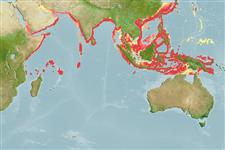Environment: milieu / climate zone / depth range / distribution range
Sinh thái học
Biển; Thuộc về nước lợ Sống nổi và đáy; Ở đại duơng, biển (Ref. 51243); Mức độ sâu 50 - ? m (Ref. 9987). Tropical; 31°N - 12°S, 40°E - 153°E (Ref. 54462)
Indo-West Pacific: Somalia to Papua New Guinea, north to Japan and south to Indonesia.
Length at first maturity / Bộ gần gũi / Khối lượng (Trọng lượng) / Age
Maturity: Lm ?, range 13 - ? cm
Max length : 61.0 cm TL con đực/không giới tính; (Ref. 43449); common length : 25.0 cm TL con đực/không giới tính; (Ref. 30573)
Các tia vây lưng cứng (tổng cộng) : 0; Các vây lưng mềm (tổng cộng) : 11 - 13; Tia cứng vây hậu môn: 0; Tia mềm vây hậu môn: 13 - 15. Scales restricted to posterior half of the body. Posterior tip of pectoral fin reaching origin of pelvic fin.
Inhabit deep water offshore on sandy mud bottom for most of the year, but also gathers in large shoals in deltas of rivers to feed during monsoons (Ref. 9987, 11230). Spawn 6 batches of broods per year (Ref. 43449). An aggressive predator (Ref. 9987). Primarily caught along Maharashtra with the bag-net, better known as 'dol' net. Operation of this gear is timed to a strong tidal current. The bag with the mouth set against the current strains the fish which is being retained therein by the strength of the current. The net is thus retrieved before the tide turns. Very phosphorescent. Excellent food fish. Marketed fresh and dried or salted; consumed pan-fried (Ref. 9987).
Whitehead, P.J.P., 1984. Harpadontidae. In W. Fischer and G. Bianchi (eds.) FAO species identification sheets for fishery purposes. Western Indian Ocean fishing area 51. Vol. 2. [pag. var.]. FAO, Rome. (Ref. 3417)
IUCN Red List Status (Ref. 130435: Version 2024-1)
Threat to humans
Harmless
Human uses
Các nghề cá: tính thương mại cao
Các công cụ
Special reports
Download XML
Các nguồn internet
Estimates based on models
Preferred temperature (Ref.
123201): 16.8 - 26, mean 21.2 °C (based on 405 cells).
Phylogenetic diversity index (Ref.
82804): PD
50 = 0.5312 [Uniqueness, from 0.5 = low to 2.0 = high].
Bayesian length-weight: a=0.00417 (0.00321 - 0.00541), b=3.14 (3.07 - 3.21), in cm total length, based on LWR estimates for this species (Ref.
93245).
Mức dinh dưỡng (Ref.
69278): 4.1 ±0.74 se; based on food items.
Generation time: 1.5 (1.1 - 2.1) years. Estimated as median ln(3)/K based on 10
growth studies.
Thích nghi nhanh (Ref.
120179): Chiêù cao, thời gian nhân đôi của chủng quần tối thiểu là dưới 15 tháng (K=0.18-0.9; Fec=89,600).
Prior r = 1.16, 95% CL = 0.77 - 1.75, Based on 5 data-limited stock assessments.
Fishing Vulnerability (Ref.
59153): Low to moderate vulnerability (26 of 100).
Climate Vulnerability (Ref.
125649): Moderate to high vulnerability (53 of 100).
Nutrients (Ref.
124155): Calcium = 58.7 [27.2, 166.1] mg/100g; Iron = 0.333 [0.155, 0.934] mg/100g; Protein = 12.3 [10.2, 15.6] %; Omega3 = 0.0747 [, ] g/100g; Selenium = 28 [12, 74] μg/100g; VitaminA = 8.22 [2.60, 29.21] μg/100g; Zinc = 0.368 [0.246, 0.916] mg/100g (wet weight); based on
nutrient studies.
